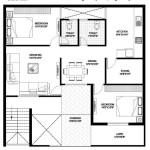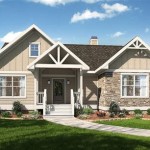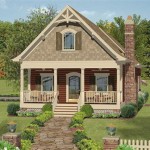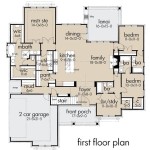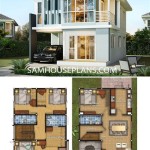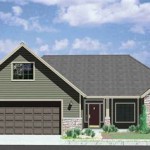3-Story Beach Home Plans: Maximizing Coastal Living
The pursuit of coastal living often involves the desire for panoramic views, ample space, and a design that harmonizes with the natural environment. Three-story beach home plans offer a compelling solution, providing an opportunity to maximize these features while navigating the specific challenges and regulations often associated with waterfront properties. These plans can be customized to suit a range of architectural styles, lot sizes, and personal preferences, making them a versatile choice for individuals and families seeking a permanent residence, vacation home, or investment property.
Planning a three-story beach home requires careful consideration of several factors, including local building codes, potential flood risks, wind resistance, and the desired aesthetic. A well-designed plan will not only meet these requirements but will also optimize the use of space, enhance the views, and provide a comfortable and functional living environment. The design process typically involves collaboration with architects, engineers, and builders who possess expertise in coastal construction.
Key Point 1: Advantages of Three-Story Design in Coastal Areas
One of the most significant advantages of a three-story beach home is the enhanced view potential. By elevating the living spaces, homeowners can capture unobstructed views of the ocean, coastline, or surrounding landscape. The upper floors can be dedicated to living areas, master suites, or outdoor decks, providing an immersive experience of the coastal environment. This vertical extension also allows for a larger footprint without expanding horizontally, which is particularly beneficial on smaller or narrow lots.
Another benefit is the mitigation of flood risk. In many coastal areas, building regulations require elevating the first floor above the base flood elevation (BFE). A three-story design inherently provides greater elevation, potentially exceeding the minimum requirement and reducing the risk of flood damage. This can translate to lower insurance premiums and greater peace of mind for homeowners.
A three-story structure can also offer increased privacy. The higher elevation can create a buffer from street-level noise and activity, ensuring a more tranquil living environment. Furthermore, the separation of living spaces across multiple floors can provide greater privacy for family members or guests.
Beyond these practical advantages, a three-story design can create a sense of grandeur and architectural interest. The vertical lines of the structure can complement the horizontal expanse of the beach, creating a visually appealing contrast. With thoughtful design, the home can become a landmark in the coastal landscape.
The potential for increased rental income is another significant benefit, especially if the home is intended as an investment property. Homes with superior views, ample space, and multiple bedrooms tend to command higher rental rates, making a three-story beach home a potentially lucrative investment.
Key Point 2: Design Considerations and Building Codes
Designing a three-story beach home requires a thorough understanding of local building codes and regulations. These codes are often more stringent in coastal areas due to the heightened risks associated with wind, water, and seismic activity. Adherence to these codes is crucial for ensuring the safety and structural integrity of the home.
Wind resistance is a primary concern. Coastal structures must be designed to withstand high winds, including hurricane-force winds. This may involve using reinforced construction materials, securing the roof with specialized fasteners, and incorporating design features that minimize wind pressure. Common techniques include using hurricane straps to tie the roof to the walls and installing impact-resistant windows and doors.
Flood resistance is another critical consideration. Building codes typically require that the lowest floor of the home be elevated above the base flood elevation (BFE). This can be achieved through various methods, such as building on pilings, creating a raised foundation, or using breakaway walls that are designed to collapse under hydrostatic pressure. Proper drainage and landscaping are also important for managing stormwater runoff.
Seismic activity is a concern in some coastal regions. In these areas, the design must incorporate seismic-resistant features, such as reinforced concrete foundations, shear walls, and flexible connections. These features help to absorb and dissipate energy during an earthquake, minimizing the risk of structural damage.
Accessibility is another important factor to consider, particularly for homeowners with mobility challenges or who plan to age in place. Incorporating an elevator or designing for future elevator installation may be necessary to ensure access to all floors. Ramps and wide doorways can further enhance accessibility.
Energy efficiency should also be a priority. Coastal areas can experience extreme temperatures, so it is important to design the home to minimize energy consumption. This can be achieved through various strategies, such as using high-performance windows and insulation, installing energy-efficient appliances, and incorporating passive solar design principles. Solar panels can also be a viable option for generating renewable energy.
Key Point 3: Architectural Styles and Interior Design
Three-story beach home plans can be adapted to a wide range of architectural styles, from traditional to contemporary. The choice of style will depend on personal preferences, the surrounding landscape, and the desired aesthetic. Each style offers unique characteristics that can enhance the beauty and functionality of the home.
Coastal contemporary is a popular style that emphasizes clean lines, open spaces, and abundant natural light. This style often incorporates large windows and sliding glass doors to maximize views and create a seamless connection between indoor and outdoor living areas. Neutral color palettes, natural materials, and minimalist furnishings are characteristic of this style.
Traditional coastal styles, such as Cape Cod or Shingle Style, evoke a sense of timeless elegance and charm. These styles often feature gabled roofs, dormers, and clapboard siding. Interior design typically incorporates comfortable furnishings, nautical accents, and warm color palettes.
Mediterranean-inspired designs offer a touch of old-world charm. These styles often feature stucco exteriors, terracotta roofs, and arched doorways. Interior design typically incorporates rich colors, ornate details, and comfortable seating areas.
The interior design of a three-story beach home should reflect the coastal environment and lifestyle. Choosing durable and easy-to-maintain materials is essential, as beach homes are often subject to sand, salt air, and moisture. Fabrics and finishes should be resistant to fading and stains.
Open floor plans are well-suited for beach homes, as they allow for easy flow and maximize views. The kitchen, dining area, and living room can be combined into one large space, creating a welcoming and social atmosphere. Outdoor decks and balconies should be accessible from the main living areas, extending the living space and providing opportunities for relaxation and entertainment.
Careful attention should be paid to the placement of windows and doors to maximize natural light and ventilation. Cross-ventilation can help to reduce the need for air conditioning, while properly positioned windows can capture stunning views. Skylights can also be used to bring natural light into interior spaces.
The selection of furniture and accessories should complement the architectural style and create a comfortable and inviting atmosphere. Comfortable seating, durable rugs, and nautical-themed décor can enhance the coastal aesthetic. Storage solutions are also important, as beach homes often require ample space for storing beach gear, water sports equipment, and other recreational items.
Landscaping plays a crucial role in enhancing the curb appeal and functionality of a three-story beach home. Native plants are well-suited for coastal environments, as they are adapted to sandy soils, salt air, and windy conditions. Proper landscaping can also help to stabilize the soil, prevent erosion, and provide shade.
Ultimately, the design of a three-story beach home should be a reflection of the homeowner's personal style and preferences. By working closely with architects, engineers, and interior designers, it is possible to create a stunning and functional home that perfectly captures the essence of coastal living. The careful planning and execution of the design will ensure that the home is not only beautiful but also durable, safe, and energy-efficient.

Beach House Plan Caribbean Home Floor 3 Story Plans Coastal

3 Story Coastal Style House Plan Tiger Beach Floor Plans

South Florida Design Beach Style 3 Story House Plan

Step Inside Beach House With Open Floor Plan And A Lookout Tower Plans Coastal

Plan 058h 0023 The House

3 Story Coastal Style House Plan Tiger Beach
House Plan 175 1070 3 Bedroom 3938 Sq Ft Coastal Beachfront Home Tpc Malibu

3 Story Beach House Plan Siesta Key Virtual Tour

Plan 62802dj Beach House With Third Floor Lookout Plans

Beach House Plans Floor Designs Houseplans Com

